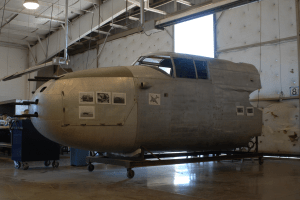
In the hangar at the aviation campus on the edge of the Tarmac at Fresno Yosemite Airport sits a piece of American history: the nose, cockpit, and fuselage of a North American B-25 Mitchell.
“We’ve only had it about a month,” says Program Director Richard Simmons. “It’ll be here for at least a year or more.”
Rescued from the scrap heap by a local airfield and museum, the WWII bomber will provide a unique training opportunity for students with a future in aircraft maintenance.
The same model used by Colonel Doolittle in his daring raid over Tokyo, this medium bomber was a mainstay of Allied air corps from the Pacific to the Middle East. This particular plane was stationed in North Africa, judging by the brown paint job, and likely later took part in the invasion of Italy.
Ironically enough, the plane survived the fires of war only to be permanently grounded when it was crash landed for the 1992 Mel Gibson film Forever Young. After that stunt, it was unlikely this B-25 would ever fly again. But it still can help modern students to learn their trade.
“They really crashed it,” says Simmons. “You can see the dents in the fuselage.”
Despite being over half a century old, the aircraft presents special learning opportunities for students of the aviation school.
“It’s not all that different,” says Simmons, referring to the methods of maintaining aircraft from WWII to present.
Fixing a vintage plane will help a student gain the skills to fix modern aircraft.
Students will have to replace portions of the fuselage bent and dented from the crash, as well as replace the few support ribs that buckled under the stress of a landing without deployed landing gear. The original flooring will be installed, and proper glass will be fitted to the cockpit and gun turrets. Lastly, the jammed bottom hatch will be made usable.
Once the repairs are complete, the plane will leave the aviation campus bound for Eagle Field to be used as a museum piece. Patrons will be able to climb inside the cockpit and get a personal glimpse into our nation’s past.
One cannot help but feel envious of the students at the aviation campus. Not only are they learning the skills to keep planes in the skies, they also have the privilege to keep history alive for future generations.
“It’s just wonderful that they would be willing to trust us with restoring this historic airplane,” says Campus Director Jack MacFarlene. “It’s truly an honor.”
